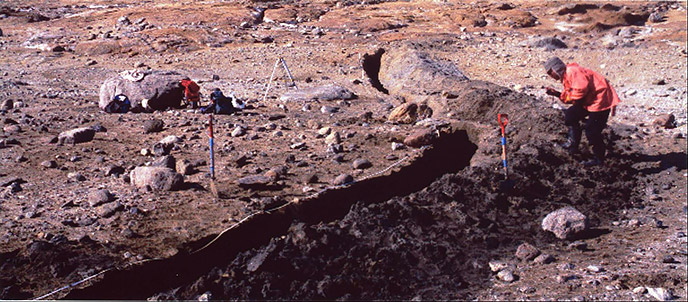National Institute of Polar Research
Understanding Antarctic ice historic changes could reveal future changes
Released on August 19, 2021 (in Japanese)
Posted on August 23, 2021
Researchers suggest that the Antarctic Ice Sheet partly reached its maximum thickness before the Last Glacier Maximum.
The Antarctic Ice Sheet, Earth’s southern polar ice sheet, has grown and receded and grown again over millions of years. This changing mass influences the planet’s climate and sea levels, with historic data recorded in sediment, meltwater and surrounding oceans. However, the remote and difficult nature of the sheet leaves researchers with limited access to collect samples and data that may reveal missing pieces in the ebb and flow of historic climate changes.
The results were published on June 14 in Geology.

Sediment sampling in Antarctica. (Credit: Hideki Miura JARE35/NIPR)
“An accurate reconstruction of Antarctic Ice Sheet changes is required to develop a further understanding of ice-sheet response to climate changes,” said paper author Takeshige Ishiwa, postdoctoral researcher at the National Institute of Polar Research, Research Organization of Information and Systems.
According to Ishiwa, ice sheet changes before the Last Glacial Maximum about 20,000 years ago, when the ice sheets across the globe were their most extensive, have not been well documented. With limited records, there are inconsistencies in modeled data and geological observations. For example, despite a global sea level drop of more than 40 meters before the Last Glacial Maximum, sedimentary samples from two bays in East Antarctica indicate sea levels did not differ much from modern measurements.
To better understand this inconsistency, the researchers modeled how land under the ice sheet moves, called glacial isostatic adjustment. Even when ice melts, the land has long-lasting effects and moves differently as a result. The researchers simulated various scenarios and found that only one appeared to explain the sea level discrepancy.
“Our glacial isostatic adjustment modeling results reveal that the Indian Ocean sector of Antarctic Ice Sheet would have been required to experience excess ice loads before the Last Glacial Maximum in order to explain limited geological data,” Ishiwa said. “We suggest that the Antarctic Ice Sheet partly reached its maximum thickness before the Last Glacier Maximum.”
The thicker ice appears to have depressed the continent, Ishiwa said, changing the gravitation field of the land and sea to generate the high sea levels.
“Geological evidence supports our glacial isostatic adjustment-based Antarctic Ice Sheet reconstruction before the Last Glacial Maximum,” Ishiwa said, noting how sediment and meltwater data indicates that the ice sheet had partially decayed before the Last Glacial Maximum.
The researchers plan to conduct another field survey and obtain additional geological data to better understand changes in the Antarctic Ice Sheet.
Co-authors include Jun’ichi Okuno and Yusuke Suganuma, both with the National Institute of Polar Research and the Department of Polar Research Science, School of Multidisciplinary Science, The Graduate University for Advanced Studies (SOKENDAI).
Original article:
Journal: Geology
Title: Excess ice loads in the Indian Ocean sector of East Antarctica during the last glacial period
Authors:
Takeshige Ishiwa (National Institute of Polar Research, Japan)
Jun’ichi Okuno (National Institute of Polar Research, Japan)
Yusuke Suganuma (National Institute of Polar Research, Japan)
DOI: 10.1130/G48830.1
URL: https://pubs.geoscienceworld.org/gsa/geology/article/doi/10.1130/G48830.1/600851/Excess-ice-loads-in-the-Indian-Ocean-sector-of
Published Online: JUNE 14, 2021
Funding:
The Japan Society for the Promotion of Science, the TOREY Science Foundation and the Giant Reservoirs-Antarctic program supported this work.








